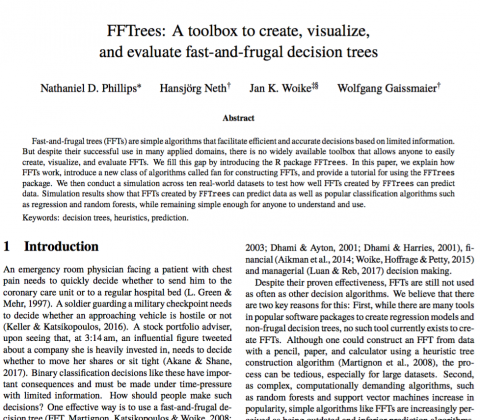Posts Tagged: uncertainty
(vs. risk)


riskyr: A toolbox for rendering risk literacy more transparent
so as to make the solution transparent.
Hansjörg Neth, Felix Gaisbauer, Nico Gradwohl, Wolfgang Gaissmaier
riskyr: A toolbox for rendering risk literacy more transparent
Abstract: Risk-related information — like the prevalence of conditions and the sensitivity and specificity of diagnostic tests or treatment decisions — can be expressed in terms of probabilities or frequencies. By providing a toolbox of methods and metrics, the R package riskyr computes, translates, and displays risk-related information in a variety of ways. Offering multiple complementary perspectives on the interplay between key parameters renders teaching and training of risk literacy more transparent.


Paper: FFTrees: An R toolbox to create, visualize, and evaluate FFTs
is nevertheless totally incomprehensible to a human expert, can it
be described as knowledge? Under the common-sense definition of this term
as material that might be assimilated and used by human beings, it is not…
Nathaniel Phillips, Hansjörg Neth, Jan Woike, Wolfgang Gaissmaier
FFTrees: A toolbox to create, visualize, and evaluate fast-and-frugal decision trees

An example of an FFT predicting the risk of having heart disease.
Abstract: Fast-and-frugal trees (FFTs) are simple algorithms that facilitate efficient and accurate decisions based on limited information. But despite their successful use in many applied domains, there is no widely available toolbox that allows anyone to easily create, visualize, and evaluate FFTs. We fill this gap by introducing the R package FFTrees.


Artikel: Warum erfolgreiche Prognosen einfach und unsicher sind
(Vyacheslav Molotov, 1954, see Wikiquote)
Hansjörg Neth, Wolfgang Gaissmaier
Warum erfolgreiche Prognosen einfach und unsicher sind
Von der Wahl des richtigen Werkzeugs für Wähler und die Wahlforschung
Aus der Einleitung: Für Entscheidungswissenschaftler sind Wahlen – ungeachtet aller Warnungen – ein großartiges und größenwahnsinniges Experiment. Während wir sonst das Entscheidungsverhalten von Individuen und Gruppen in kontrollierten Laborsituationen erforschen, werden bei Wahlen die Meinungen von Millionen Menschen über mehrere Monate systematisch manipuliert und dann ein bundesweites Aggregat ihrer Mehrfachauswahlentscheidungen gebildet, das die Zusammensetzung von Parlament und Regierung und damit die Politik der nächsten Jahre determiniert. Auch wenn das Experiment ethisch nicht unbedenklich und seine Aussagekraft in Ermangelung einer Kontrollgruppe erheblich eingeschränkt ist, finden sich auf der gesamtgesellschaftlichen Ebene viele Elemente wieder, deren Mechanismen wir im mikroskopischen Maßstab aus unseren Studien kennen.


